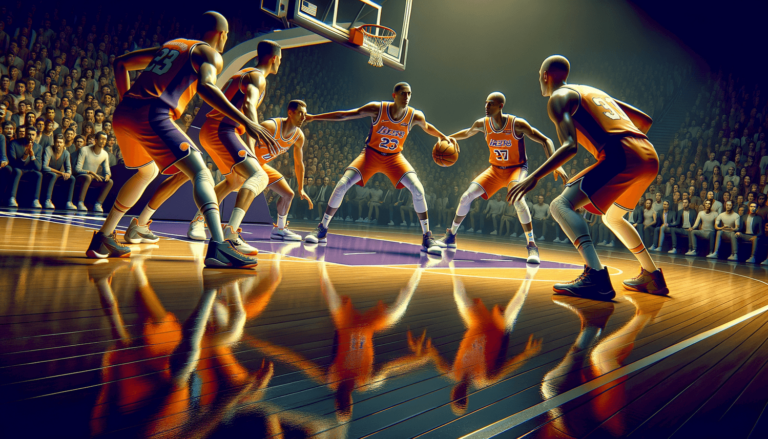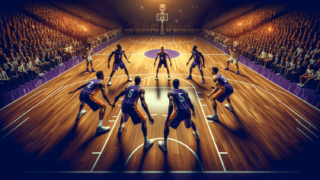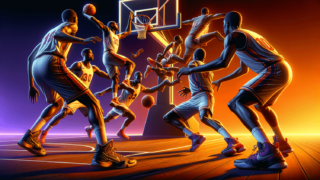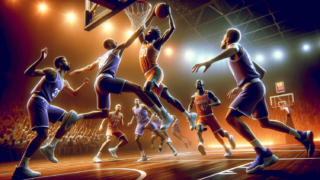
What’s a Help and Recover Defense in Basketball?
Written by: Basketball Universe
Last updated:

Have you ever found yourself in a game of hoops wondering how to maximize your defensive impact? Well, you’ve come to the right place to unlock your defensive superpowers! In this blog post, we’ll be diving into the rapidly evolving world of basketball defense, specifically, the dynamic and highly effective Help and Recover strategy. This approach to team defense has become an integral component for teams looking to establish a robust and aggressive barrier against their opponents. So, whether you’re a beginner or a seasoned player, buckle up as we take a deep dive into the intricacies of the Help and Recover Defense in basketball, breaking it down step-by-step to help improve your overall game!
What’s a Help and Recover Defense in Basketball?
A Help and Recover Defense in basketball is a strategy where a player temporarily leaves their assigned offensive player to provide help or support in defending an attacking opponent. Once the immediate threat is neutralized, the helping player then quickly returns, or “recovers,” to their original defensive assignment. This approach emphasizes teamwork, communication, and agility, fostering a cohesive and robust defense against the opposing team.
Importance of Help and Recover in Modern Basketball
In the contemporary era of basketball, the game’s pace and offensive strategies have shifted significantly. Offenses are now more dynamic, featuring complex plays, improved spacing, and increased three-point shooting. As a result, effective team defensive schemes that adapt to this change are invaluable. That’s where the Help and Recover Defense strategy enters the picture, providing teams with a versatile and streamlined approach to mitigating opponents’ offensive threats.
Mastering the Art of Helping: Expanding Your Defensive Arsenal
Understanding the Defensive Principles
Before diving deep into learning the Help and Recover strategy, it’s essential to comprehend the basic idea behind it. In basketball, two primary categories of defense exist: player-to-player defense and zone defense. Player-to-player defense entails each defensive player being responsible for a specific opponent. However, in zone defense, each player guards a specific region of the court rather than an individual.
Help and Recover Defense is a hybrid approach that incorporates elements of both player-to-player and zone defenses. It enables individual players to assist their teammates in guarding specific threats while maintaining overall coverage of their respective assignments.
Perfecting the Help Position
The initial step in becoming an effective Help and Recover defender is mastering the help position. This involves:1. Keeping an eye on both your assigned offensive player and the ball handler.2. Understanding the help-side and ball-side concepts. The help-side of the court is where the ball is not, while the ball-side is where the action is happening.3. Positioning yourself at an ideal distance from your opponent to provide the necessary support for your teammate in case of an attempted penetration.4. Evaluating the skills and strengths of your assigned offensive player to balance when you should help and when you should focus solely on your matchup.Developing these habits will allow you to make smarter and faster decisions as a help defender under various game situations.
Efficiently Recovering to Keep Your Opponent in Check
Importance of Communication
Smooth and constant communication is critical for a seamless transition from helping to recovering. Talk to your teammates and let them know when you’re leaving your assignment to provide help. Continuous communication builds trust, reduces confusion, and enables your teammates to adjust their positions to compensate for your temporary absence effectively.
Reading the Offense
An essential component of recovering successfully is the ability to anticipate and read the offensive player’s movements. It’s vital to have a clear understanding of your opponent’s style, strengths, and weaknesses, as well as the team’s offensive schemes. Familiarizing yourself with your competitor’s tendencies allows you to predict their next move, thereby enabling you to recover more efficiently.
Recovery Techniques
Now that we’ve addressed the foundational aspects of recovering, let’s dive into the techniques that will enable you to execute the defensive strategy with precision. Here are some crucial recovery methods to master:1. Closed-out Recovery: This technique involves sprinting back to your assigned offensive player and abruptly stopping to prevent an attempted drive or shot. It allows you to close the gap quickly while maintaining control of your movement.2. Hard Recovery: In this approach, you recover aggressively and rapidly to your original assignment while closing out on the offensive player. It involves contesting shots or preventing drives while maintaining pressure on the ball handler.3. Trail Recovery: Sometimes, you may find yourself recovering from behind your assigned player. In this technique, you chase the offensive player and prevent easy cuts or drives, using your agility and speed to disrupt their game.These recovery techniques will enable you to transition effectively from helping to guarding your assigned player without compromising the overall defense.
Help and Recover: Executing as a Team
Synergy and Team Chemistry
A successful Help and Recover Defense significantly relies on seamless execution as a coordinated unit, emphasizing teamwork and overall synergy. Developing chemistry and trust among teammates is crucial, as it allows players to communicate and make adjustments fluidly on the court, especially in high-pressure situations. Continual practice and communication, both on and off the court, are essential for building a well-functioning defensive machine.
Rotating to Cover Other Assignments
While you might be the one providing the help, your teammates must also be prepared to adapt and fill in the gaps. When you leave your assignment, your teammates should move to compensate for the open player. Continual rotations are critical to prevent the offensive team from capitalizing on a momentarily unguarded player, leaving no room for easy scoring opportunities.
Adjusting to Player and Team Strengths
Each player on a team has varying abilities and skill sets, and the Help and Recover Defense should be adjusted accordingly. For instance, if your team has quick, agile players, you can opt for a more aggressive defense with frequent helping and recovering. Conversely, if your team is more comfortable with conventional player-to-player defense, you might opt for a conservative Help and Recover strategy based on specific situations.Additionally, consider the strengths and weaknesses of the opposing team. Adapt your defensive approach to exploit vulnerabilities and minimize their offensive power.
Building a Dynamic Basketball Defense: Drills and Practice
Implementing the Shell Drill
The Shell Drill is a classic basketball drill that effortlessly translates into the Help and Recover Defense. Players arrange themselves in a square or diamond formation, with an offensive player positioned against each defender. As one of the offensive players takes possession of the ball, the corresponding defensive player transitions into a 1-on-1 defense, and other defenders adjust their positions accordingly.
Continually practicing this drill with a focus on proper help positioning, communication, and recovery techniques helps ingrain the Help and Recover principles into your team’s overall defensive mentality.
Developing Speed and Agility
To be an effective Help and Recover defender, a player must possess exceptional speed and agility. Incorporating speed-focused drills, such as ladder drills, agility cones, and sprints, can dramatically bolster a player’s rate and ability to change directions quickly. This foundation will significantly aid in transitioning between helping and recovering with minimal delays.
Building Strength and Conditioning
Help and Recover Defense is an aggressive and energetic style of play that demands high levels of physical fitness. Stamina and strength training should be an integral part of your conditioning program to ensure you can maintain the intensity and quick movements required throughout the entire game.
From Good to Great: Elevating Your Defensive Game
Employing a Help and Recover Defense in basketball is undoubtedly an effective approach to shutting down opponents and adapting to the evolving nature of the game. By mastering the principles and techniques involved in helping, recovering, and working as a unit, your team can elevate its defensive prowess to entirely new levels.
Delve into the world of Help and Recover Defense with an open mind, continual practice, and unyielding determination, and watch your defensive impact skyrocket on the basketball court!
Recognizing and Counteracting Common Offensive Strategies
Understanding potential offensive threats is a significant aspect of embracing the Help and Recover Defense, as it equips defenders to react to various game situations effectively. Here’s a closer look at some common offensive strategies and how the Help and Recover Defense can counteract them:
Pick and Roll
The pick and roll is a widely utilized offensive play in basketball, where a player sets a screen for the ball handler, followed by the screener rolling towards the basket for a pass. To counteract this play using the Help and Recover Defense, the defender guarding the screener will temporarily help on the ball handler, while the original defender of the ball handler fights through the screen. Once the initial defender recovers, the helping defender will return to their original assignment (the screener) and re-establish defensive positioning.
Drive and Kick
The drive and kick is another popular offensive play that capitalizes on the ball handler’s ability to penetrate the paint and kick the ball out to an open shooter on the perimeter. In this case, a help defender will temporarily leave their assignment, close the driving lane, and force the ball handler to pass. As the ball handler kicks the ball out to the perimeter, the helper recovers quickly to their original assignment to contest any potential shot or drive.
Off-Ball Screens and Cuts
Off-ball screens and cuts are designed to create open opportunities for a player away from the ball. In these situations, the defender must stay aware of both the ball and their assignment, maintaining adequate positioning to help and recover as necessary. When a player receives a screen to become open, the defender of the screener should step back temporarily to disrupt the scoring opportunity until the original defender recovers from the screen. Other defenders should also be ready to rotate or provide additional help if required.
Help and Recover in the NBA: Examples and Influential Teams
To further grasp the Help and Recover Defense’s value and effectiveness, it’s essential to observe how professional NBA teams implement this strategy. Here are examples of some influential teams dominating the defensive end with their Help and Recover capabilities:
Golden State Warriors
During their championship run (2015-2019), the Warriors showcased a nearly flawless Help and Recover Defense, which often went underappreciated due to their offensive prowess. Led by players like Draymond Green, Klay Thompson, and Andre Iguodala, the team exhibited a collective defensive effort with seamless rotations and extraordinary help-side support. Their aggressive defensive presence frequently led to transition opportunities and fast-breaks, propelling them to victory.
Miami Heat
The Miami Heat (2011-2014) utilized an aggressive trapping Help and Recover Defense, headlined by players like LeBron James, Dwyane Wade, and Chris Bosh. This defensive strategy forced opponents into low-percentage shots and turnovers, with each player stepping in to provide help when needed and recovering quickly to their respective assignments. It was a vital component of their success during their back-to-back Championship seasons in 2012 and 2013.
Watching and studying these teams at work can provide valuable insights into the impact of the Help and Recover Defense in elite-level basketball, offering inspiration to teams at all levels to unlock their defensive potential.
Frequently Asked Questions (FAQ) Section
In this FAQ section, we will address common questions related to Help and Recover Defense in basketball, targeting essential aspects and concerns of players and coaches looking to enhance their defensive skills. Equip yourself with answers to the following frequently asked questions to strengthen your knowledge and understanding of this dynamic defensive strategy.
1. Is Help and Recover Defense suitable for all levels of basketball, including youth leagues?
Yes, the Help and Recover Defense can be employed at all levels of basketball, including youth leagues. Teaching young players the value of teamwork and communication through this defensive strategy will set a strong foundation for their future development.
2. How does Help and Recover Defense differ from traditional player-to-player or zone defenses?
Help and Recover Defense is a hybrid approach incorporating elements from both player-to-player and zone defenses. Unlike strictly following a specific player or guarding a region on the court, this strategy encourages defenders to provide temporary help to teammates while still maintaining responsibility for their initial assignments.
3. Can Help and Recover Defense be used against all offensive plays?
While Help and Recover Defense is highly versatile, its effectiveness may vary depending on the specific offensive play being executed. Adjusting your defensive approach to match your team’s strengths and counter your opponents’ strategies is crucial to maximize results.
4. How can I improve my decision-making as a help defender in the Help and Recover scheme?
To improve decision-making, focus on developing a strong understanding of fundamental defensive positioning, reading offensive plays, and maintaining an awareness of both the ball and your assigned player. Continual practice, observation, and communication will help refine your decision-making ability.
5. Is there a risk of too much helping, negatively impacting the team’s overall defense?
Over-helping can indeed pose risks, such as leaving assigned players open for longer periods or causing unnecessary rotations. Striking a balance between helping and guarding your assigned player is key. Proper communication, team chemistry, and an understanding of each player’s skill set will aid in minimizing these risks.
6. What type of players benefits the most from the Help and Recover Defense strategy?
Players with excellent speed, agility, and the ability to quickly change directions are ideal for executing the Help and Recover Defense. However, all players can benefit from this strategy, as it emphasizes teamwork, communication, and adaptability.
7. Can a team run Help and Recover Defense throughout the entire game?
A team can employ the Help and Recover strategy throughout the game. However, adjusting your defensive approach based on evolving game situations, opponents’ strengths or weaknesses, and your team’s capabilities is important for optimal success.
8. What challenges should we expect when first implementing the Help and Recover Defense into our team’s game plan?
Some challenges to expect when first implementing this strategy include building seamless communication, developing practical decision-making, and fostering a mindset of constant help and recover. Regular practice, patience, and focus on refining the fundamentals will help alleviate these challenges.
9. When should a player help and recover during a fast break?
During a fast break, a player should help if they can impede the path of an attacking opponent, forcing them to change direction or pass the ball. Once the threat is neutralized, the helping player should recover quickly to their original assignment, preventing any easy scoring opportunities.
10. How can a coach measure their team’s progress in adopting the Help and Recover Defense?
A coach can measure their team’s progress by evaluating the rate of successfully neutralized offensive plays, the number of forced turnovers or low-quality shot attempts, and the overall flow of communication during games. Additionally, coaches can use video analysis to identify areas of improvement and reinforce team development.
Featured Posts
- No pillar pages found.





